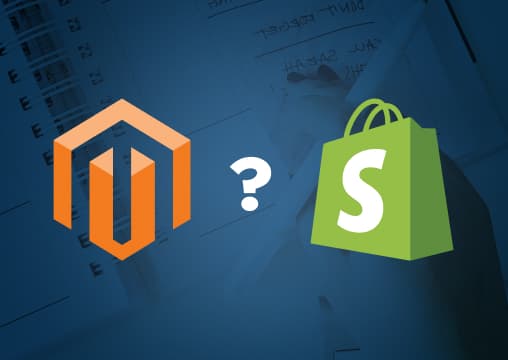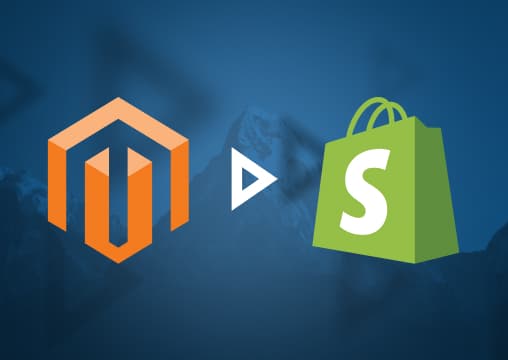
Magento vs Shopify
In 2022, Magento ranked #8 on the “e-commerce platform used by the top 1 million sites” list. Shopify, on the other hand, ranked number 4.
Despite this, many users still blatantly prefer Magento – and we think this may be because back in its glory days, Magento used to pull in higher rankings (and had been a customer favorite for many years).
So, loyalty and all that. But are you just hanging onto the platform for old times’ sake (or because you’re so accustomed to it)? In other words, does it really make sense for you?
In this article, we’ve taken a look at both solutions to see how they rank based on pricing, third-party integrations, themes, usability, marketing and functional features, security, and other factors.
Hopefully, by the end of this article, you should know if Magento still stands to be an ideal choice for your business or if you might benefit from shifting to Shopify.
- What is Magento?
- What is Shopify?
- Magento vs Shopify: Pricing
- Magento vs Shopify: Themes and Templates
- Magento vs Shopify: Apps & Extensions
- Magento and Shopify marketing and functional features
- Which has better support and security?
- Shopify Magento comparison: Usability
- Conclusion
What is Magento?

Developed in 2008, Magento is one of the few open-source platforms that allows online stores to set up their operations. While Magento, Inc. is the original developer and owner of the solution, in 2018, Adobe made the decision to acquire it for the hefty amount of $1.68 billion.
Oh, and before being absorbed by Adobe, Inc., Magento also belonged to eBay and Permira.
At the present moment, there are two variations of this solution: Magento Community and Magento Enterprise. While the former is targeted towards smaller businesses, the latter is targeted towards enterprise-level companies, such as Land Rover, Timex, Sigma Beauty, Cox and Cox, Graze, Tennishub, Neom Organics, and more (yes, all these websites are made on Magento 2).
What is Shopify?

Developed in Ontario, Canada, Shopify was created well before Magento (founded in 2006). However, it really saw success post the 2010s.
Much like Magento, Shopify, too, has two different variations available: Shopify and Shopify Plus. And exactly like Magento, both these versions cater to two different markets — the former caters to smaller and medium businesses, whereas the latter caters to enterprise brands.
In recent years, Shopify has also expanded its capabilities to include last-mile logistics as a part of its service.
The brand’s reps have also mentioned that, by 2021, the platform had more than 1.7 million businesses as a part of its client roster, platform availability in 175 countries, and earned a total revenue of around 4.6 billion US dollars.
Magento vs Shopify: Pricing
Let’s consider the pricing of Magento and Shopify by categorizing them into different aspects, such as:
- Platform cost
- Hosting cost
- Themes and apps
- Setting up a store
- Credit card and payment processing fees
1. Platform cost
Shopify currently has three pricing options available on its page: Basic, Shopify (also known as Standard), and Advanced. The Basic version is available for $29/month, the Standard version is available for $79/month, and the Advanced version is available for $299/month. As per the current offers Shopify is running, users may save around 10% on the pricing if they subscribe to a yearly membership.
If users wish to access premium features, then they may look at Shopify Plus, whose pricing begins at $2000 (if you generate revenue up to $800,000 per month). However, if you generate around a million dollars every 30 days, you’ll have to pay $2500/month; likewise, you will be charged $12,500/month if you generate 5 million dollars in revenue, $30,000/month if you generate 12 million dollars worth of revenue, and $40,000/month if you end up earning upwards of 16 million dollars (all monthly totals — go you!).
On the other hand, the community version of Magento is free to use — however, it requires you to work with a web developer to set up the site (which may very well may end up costing you about $25-$200/hour if you hire an agency, $20-$200/hour if you hire a freelancer, and around $60,000-$120,000/year if you get it done in-house). The prices and salaries of web developers change depending on the experience, expertise, and location of the web developers.
The enterprise version of Magento (which is often compared to Shopify Plus) is not free to use — buying its license will end up costing users upwards of $22,000/year. If they generate between one to five million dollars in revenue, then the cost goes up to $32,000/year, and it only increases from there ($49,000/year for revenue between one to ten million dollars, $75,000/year for revenue between ten to 25 million dollars, and $125,000/year for revenue between 25 to 50 million dollars).
Please note that there is a cloud version of Magento Enterprise, too, whose prices start at $40,000/month (for gross sales between 0 and 1 million dollars), and go up to $190,000/year for sales revenue capped at 50 million dollars.
2. Hosting cost
Did we mention that web hosting is not included as a part of Magento’s service offering? This is another thing that you’ll have to pay for. According to Cloudways, these hosting services may end up costing an average of $40 per month, but to find a good hosting provider whose services best fit your business, you may end up paying more.
For example, Digital Ocean’s prices start at $12/month and go up to $96/month (almost the same as Linode’s). Vultr’s prices start at $13/month and go up to $100/month. On the other hand, service providers like AWS and Google Cloud may cost anywhere between $36.51/month to $274.33/month and $33.18/month to $225.93/month, respectively.
On the other hand, Shopify doesn’t charge users a single penny for web hosting — unless of course, you have the Starter plan. Otherwise, all Shopify plans have unlimited hosting.
3. Themes and apps
Shopify does have free themes on its platform, but if users wish to opt for the paid version, then they may cost anywhere from around $180 to $350. Apps, too, cost a fee (because there are more than 6000 apps on the platform, it’s difficult to discern a proper range in pricing, but most apps may end up costing around $20/month).
Magento themes, on the other hand, can cost users anywhere between $0 and $500, depending on the kind of project you want. Users can get app extensions on Magento, too — some of them cost $0, and others cost upwards of $700 (and there are many other pricing options in between).
4. Setting up a store
Shopify stores can be created either by doing it yourself or by hiring experts. However, one thing we’d recommend is that you verify your professional is backed by Shopify, either as a partner (that’s us!) or as an expert on their marketplace.
Shopify experts may charge anywhere between $100 and $27,000 for setting up your site, depending upon how complex you want it to be. Other factors, like how experienced your experts are and where they reside, also play a huge part in the pricing.
Magento requires you to hire a web developer to get the task of setting up your website done (you can do it yourself, too, but only if you have web development knowledge). Magento experts will charge you between $20,000 – $30,000 for simpler projects, around $30,000 – $50,000 for complex projects, and anywhere from $50,000 to $100,000 for projects demanding a high degree of complexity.
Developers residing in other parts of the world, like India, Pakistan, Vietnam, etc., may charge lesser rates (but, again, this varies from developer to developer —- plus, we’re also huge fans of paying for the talent, rather than the location).
If you wish to migrate from Magento to Shopify, then the migration may cost between $500 – $42,000 depending on the complexity of the projects, the data involved, and how complex the infrastructure is.
5. Credit card and payment processing fees
If business owners wish to use Shopify Payments, then the company promises that there are no transaction fees involved. However, in cases of a third-party payment provider being involved, then the basic plan will be charged at 2%, the Shopify plan will be charged at 1%, and the Advanced plan will be charged at 0.5% in transaction fees.
Credit card transactions require you to pay extra, too. So, if you accept major credit card services like Visa or Mastercard, then you’d be charged 2.9% + 30 cents for the Basic plan, 2.6% + 30 cents for the Shopify plan, and 2.4% + 30 cents for the Advanced plan, per transaction.
Like Shopify, Magento, too, doesn’t have any transaction fees. However, if you allow payments through third-party payment providers, then that’ll cost an extra fixed percentage of the fee (standard rates are 2.9% plus a few extra cents amongst service providers), but there is no set-up fee involved.
Please note: The aforementioned service providers (like Mastercard) require a minimum number of monthly transactions (for example, right now, it lists a £105 minimum monthly transaction fee on the Magento marketplace).
Magento vs Shopify: Themes and Templates
Now that we’ve discussed pricing in our Magento vs Shopify debate, let’s move on to the next section and discuss themes and templates.
As per Shopify’s claims, Magento only has 11 themes, and they’re all paid. But, according to our independent research, we saw that Magento only has five themes listed on its marketplace, and they range from free to costing around $499.
Shopify, on the other hand, has more than 70 themes and a few of them are entirely free to use. The rest, however, may end up costing users (nothing more than $350, though). Both platforms have extremely responsive themes that would be fit for a varied number of products. But, because of the number of options Shopify provides (which are specific to niche industries), for us, Shopify takes the win in this section.
Another reason why Shopify gets brownie points is because all their themes are mobile-friendly and optimized as such (not all Magento themes are optimized for mobile), have tons of options for customizations, and they allow users to integrate social platforms.
Magento vs Shopify: Apps & Extensions
To make the process of operating on the platform easier, both Shopify and Magento offer apps and extensions.
Shopify has over 6000 apps available on the app store. Magento, on the other hand, has less than 4000 apps. Despite Magento and Shopify offering extensive options for add-ons, a common agreement between experts is that the kind of apps Shopify has on its platform are more sophisticated and likely used more often.
Aside from the quality of apps, there is another concern with the extensions Magento provides. See, because Magento is open-source, this means that users are required to learn how to install apps on the solution.
So, again, Shopify does rank a little higher in this section, too (for us). However, you might have different needs for your business, so we recommend you check out the Magento marketplace and the Shopify app store to decide which solution’s apps and extensions you like the most.
Please note: Here’s a pro that both companies get in the Magento vs Shopify debate — both have free as well as paid apps on their platform.
Magento and Shopify marketing and functional features
We’ve already discussed the important aspects of Shopify and Magento. Now, let’s take a look at the top features and have ourselves a Shopify Magento comparison.
1. Inventory handling
Both Magento and Shopify users can count on their respective solutions to manage inventory seamlessly. Here’s where they both shine equally well:
- Allowing users to have an unlimited catalog.
- Allowing users to have unlimited inventory.
- Integrating shipping as part of its service.
- Having fulfillment extensions on the platform.
But here’s where the similarities end:
- Magento is not as easy to navigate as Shopify.
- Shopify does not have personalized product delivery support.
- Magento will have running issues if you’re not on a server that’s adaptable with Magento (since Shopify hosts its own websites, they troubleshoot and correct any issues as such themselves).
2. SEO
SEO is a form of marketing activity that most businesses make some kind of accommodations for. Other forms of business highly rely on SEO to get noticed in front of prospects. So, what can both platforms offer in the way of SEO, you ask?
Shopify highly relies on its apps to do the task of SEO — that’s to say, you can download an app that would do the task of populating keywords on your website so that you rank higher with SEO — thereby making it entirely easy for you, as a user, to incorporate SEO as a part of your marketing strategy.
With Shopify, users can also input meta tags, optimize site and on-page products, can edit themes for easy readability, and benefit from fast load times and page speed — all these factors will help improve your SEO score.
Oh, and since you get an SSL certificate (which shows the algorithm you’re a trusted website), you also improve your SERP (search engine results page) rank.
Magento, too, aims to boost your SEO score, and it does this by pre-installing basic SEO features for its clients. However, it doesn’t have the best web performance nor does it allow publication of blogs or alterations of tags, which might hurt your score drastically.
On the flip side, its SEO features are pretty great — for example, it has a great site architecture, various apps for SEO, one slug for one product, generation of sitemaps automatically, 301 messages after URL change, etc.
3. Scalability
Shopify is a great platform for setting up and operating your business without any hassles or headaches. However, it’s catered toward smaller and medium businesses — the service offering that it provides can attest to the same.
For one, it has restrictions on inventory locations, and it allows 15 staff accounts at maximum (in the advanced version). Magento, on the other hand, requires a longer time to set up, is more expensive, and definitely has a learning curve (not to mention you’d need to get the help of a web developer to set up the store for you), but it is scalable.
Between Shopify and Magento, Magento is more equipped to handle larger operations, but if the argument were to compare the features of Magento and Shopify Plus, then the conversation would be a whole different ball game. This brings us to our next topic…
Magento vs Shopify Plus
When compared to Shopify Plus, Magento barely holds a candle to the light Shopify Plus emits. This is mainly because the restrictions that Shopify otherwise has (like caps on staff accounts and inventory locations) no longer exist in the mix because users can create almost unlimited staff accounts.
And Shopify Plus still retains the user convenience that the brand is so well known for (but Magento isn’t). For context, it’s easy to set up a Shopify Plus site, but it’s also closed source, meaning that it runs into no issues with security there, it also can be hosted on the cloud (and so can Magento, but its pricing for Cloud hosting starts at $40,000/yearly, which is not worth the investment for just Platform.sh hosting).
Aside from this, Shopify Plus also has a better plugin ecosystem, is more robust, allows users to set up various types of online stores, allows multi-channel support, has accommodations for omnichannel strategies, and takes less time to develop and upgrade (especially when compared to Magento).
Which has better support and security?
Shopify has 24/7 customer support, so users can get in touch with the team to ask their burning questions. It’s also self-hosted, so it’s forward-looking with respect to mitigating all issues by itself instead of waiting first for users to get in touch with them and then resolving problems.
Magento, on the other hand, has stronger community support — since it’s made by web developers, users can get in touch with web developers to best understand how to resolve their queries. Otherwise, customer support is available on Magento should users need it.
As far as security is concerned, Shopify (again) takes the cake. Because while being an open-source platform might mean good news for Magento users when it comes to creativity, the same feature backfires on them when it comes to security. Shopify also complies with PCI DSS standards, PCI SSC standards, implements SSL certificates, and boasts extra security measures like 3D password protection, two-step authentication, etc.
Shopify Magento comparison: Usability
The reason why Shopify is a fan-favorite solution for many businesses is due to its ease of use. Because the platform has drag-and-drop features to customize templates, has an excellent selection of themes and apps, and can be set up with a few clicks of a button, it has garnered positive reviews from the audience (the solution has a rating of 4.4/5 on G2).
Magento has lots of features for customization, too, but it takes users through a learning curve, requires them to employ web developers to construct the app, and has fewer themes and plug-ins than Shopify. So, although it’s a great solution, it still has lower user ratings than Shopify (G2 gave it a rating of 4/5).
Conclusion
For all the many reasons we discussed in this article, Shopify undoubtedly ranks as the better solution when compared to Magento. To briefly recap:
- It’s more affordable to develop, set up, and host.
- It has a wider variety of apps and extensions.
- The same is true for the number of themes and templates it offers.
- It even gave Magento a run for its money based on the marketing and functionality features.
- Plus, it also ranks better in ease of use.
- And it has better rankings from the same review site (G2).
Perhaps the only area where Magento was capable of really hitting Shopify was with scalability, but when we factor Shopify Plus into the mix, then we’re back to square one, with Shopify being the better solution.
If you agree with our assessment and now want to shift your operations from Magento to Shopify, then it’s time to make a switch — get in touch with MTN Haus to make it happen, as we’re a Shopify Plus partner (which means highly recommended by them) with more than a decade’s worth of experience getting the job done for our clients.
If you wish to migrate to Shopify without causing any data leaks, want to set up a professional quality site, and make it rank well on SERP metrics, we’re the people you need!




